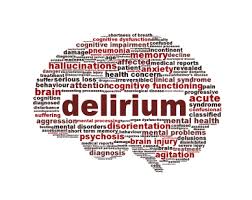- Home
- Editorial
- News
- Practice Guidelines
- Anesthesiology Guidelines
- Cancer Guidelines
- Cardiac Sciences Guidelines
- Critical Care Guidelines
- Dentistry Guidelines
- Dermatology Guidelines
- Diabetes and Endo Guidelines
- Diagnostics Guidelines
- ENT Guidelines
- Featured Practice Guidelines
- Gastroenterology Guidelines
- Geriatrics Guidelines
- Medicine Guidelines
- Nephrology Guidelines
- Neurosciences Guidelines
- Obs and Gynae Guidelines
- Ophthalmology Guidelines
- Orthopaedics Guidelines
- Paediatrics Guidelines
- Psychiatry Guidelines
- Pulmonology Guidelines
- Radiology Guidelines
- Surgery Guidelines
- Urology Guidelines
Managing ICU Delirium: Key Evidence Based Strategies

Delirium is a clinical syndrome characterized by the acute onset of cerebral dysfunction with fluctuating mental status, inattention, and either an altered level of consciousness or disorganized thinking. It is associated with increased morbidity, mortality, length of stay, and cost for hospitalized patients, especially for patients in the intensive care unit (ICU).
A review study conducted by Gregory J. Blair, MD, Stanford University School of Medicine, Stanford, CA, USA, and colleagues devised nonpharmacologic and pharmacologic minimization strategies meant for prevention and treatment of delirium in ICU patients.
The study was published in the Journal of Intensive Care Medicine.
For the purpose of the study, the researchers performed a PubMed search to review the evidence for nonpharmacologic management, pharmacologic minimization strategies, and prevention of delirium for patients in the ICU. The approaches were condensed into 10 actionable steps to manage delirium and minimize medications for ICU patients and are presented in this review.
Key strategies:
Optimize Pain Management: Adequate pain management should be a top priority for preventing and treating ICU delirium. Opioid administration, especially morphine and meperidine, is also associated with ICU delirium. Therefore, utilizing an opioid-sparing, multimodal approach to pain management (ie, utilization of regional anesthesia and/or nonopioid medications) can reduce the need for opioids in the treatment of pain in these patients and avoid opioid-related side effects.Nonpharmacologic pain management strategies such as patient positioning and turning, heat/cold therapy, and injury stabilization should also be employed to manage pain in these patients whenever possible.
Avoid Deep Sedation: Exposure to sedatives, particularly benzodiazepines, is a modifiable risk factor for delirium development. Minimizing the use of sedation in ICU patients to either maintain a light level of sedation, using daily sedative interruption, targeted sedation strategies (TSS) that continuously maintain a light level of sedation, or intermittent IV sedative bolusing, or avoiding the use of sedatives altogether significantly decrease the incidence of deep sedation and the prevalence of ICU delirium.
Eliminate Deliriogenic Medications: A daily review of each patient’s medication list and the elimination of deliriogenic medications should be performed on all ICU patients in order to reduce the risk of ICU delirium.
Facilitate Ventilator Weaning: Mechanical ventilation (MV) is the most common reason for the administration of sedatives to critically ill patients. Spontaneous breathing trial (SBT) protocols have also been shown to facilitate ventilator weaning and to decrease the duration of MV when compared to nonprotocolized ventilator management practice.
Remove Lines and Tubes: Invasive devices such as vascular and urethral catheters and endotracheal tubes can be a significant source of discomfort to ICU patients and can add to their risk of developing ICU delirium. The use of criterion-based reminders to remove invasive devices, such as ICU daily rounding checklists, hastens discontinuation of invasive devices when they are no longer indicated and allows for earlier mobilization, thereby decreasing the risk of ICU delirium and the incidence of device-related infections.
Avoid Physical Restraints: Physical restraints are often applied to prevent ICU patients, especially those with delirium, from pulling out their IV lines, catheters, and endotracheal tubes. It is also important to note that substituting deep sedation for physical restraints does not reduce the risk of ICU delirium.
Reorient ICU Patients: Reorienting patients is an effective strategy for reducing and preventing ICU delirium. Complex stimulation and enrichment for patients in the ICU are important means for prevention and treatment of delirium.
Promote Normal Sleep-Wake Cycles: Critically ill patients often experience poor sleep quality. Decreasing light and noise in the patients’ room at night while also providing earplugs and eye masks to patients and using relaxation techniques are areas identified to promote normal sleep–wake cycles in patients.
Mobilize ICU Patients Early: Intensive care unit–acquired weakness is a syndrome which can manifest as myopathy, polyneuropathy, or both. Early mobilization of critically ill patients not only decreases the incidence and severity of ICU-acquired weakness, but it also decreases the development of ICU delirium.
Engage ICU Patients and Families: There is growing recognition that engaging patient families in the ICU helps to manage symptoms of delirium in critically ill patients. Partnerships with patients’ families may provide a unique insight into effective pain management and sleep-promoting strategies for their loved ones to the health-care team.
These 10 nonpharmacologic and pharmacologic minimization interventions are more effective than specific medication strategies in preventing and treating delirium in critically ill patient. Yet many ICUs have been slow to incorporate these evidence-based delirium management strategies into clinical practice, choosing instead to routinely medicate ICU patients with delirium.
For further information click on the link: https://doi.org/10.1177/0885066618771528

Disclaimer: This site is primarily intended for healthcare professionals. Any content/information on this website does not replace the advice of medical and/or health professionals and should not be construed as medical/diagnostic advice/endorsement or prescription. Use of this site is subject to our terms of use, privacy policy, advertisement policy. © 2020 Minerva Medical Treatment Pvt Ltd